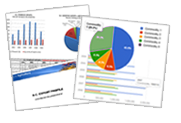1.3.8.2 Nutrient Values in Feeds/Testing
This article examines the major nutritional components of cattle feed.
Economic and nutritional considerations when using chaff and chaff/straw feedstuffs.
These tables are a summary of analysis of feeds received at Agricultural Soils and Animal Nutrition Laboratory during the ten year period from 1984 to 1994. All data with the exception of bushel weight and moisture, are reported on moisture-free (dry)...
Essential trace elements are necessary for the well being of the animal. These are needed in sufficient quantities to promote health and to optimize production. All trace elements are toxic when fed in excessive quantities.
Factsheet - Macro-elements consists of calcium, phosphorus, magnesium, sulphur, potassium and salt (sodium chloride). Table 1 shows the average levels of several of these minerals in some common feedstuffs produced in BC. Table 4 give daily requirements.
This publication is intended to familiarize livestock producers the variety of feeds available and feeding guidelines for various alternative feeds.
This publication is intended to familiarize livestock producers with the variety of feeds available and to provide feeding guidelines for various alternative feeds.
The "Why, What & How" of creep feeding calves.
$ cost/ton values of various feeds based on their nutrient contents compared with the cost of corn and soybean meal.
Kentucky forage base is composed of cool-season grasses and legumes.
Forages can be analyzed by two methods. Wet chemistry and Near Infrared Reflectance Spectroscopy (NIR). The new NIR techniques use light to quickly determine the nutritive value of hay.
Toxic levels of nitrates in forages are always a possibility whenever the normal growth of plants is disrupted by hail, drought, spray drift or frost. High levels of nitrates need not be a problem as long as the feeding program is managed correctly.
So you’ve got all your feed put up, know how much you’ve got and now want to determine how to best use it to feed your animals. To do so, feed testing and ration balancing can manage your feed supply and reduce your cost of production.
Sample rations. Replacement heifers are the future of your cow herd. Proper nutritional management will ensure heifers are an adequate size and in good body condition at breeding time. It is recommended that heifers be 65% of their mature weight.
As an Extension beef specialist, I often recommend that a producer get his/her forages analyzed by a commercial laboratory so we can design a feeding program that will economically meet the requirements of the cow herd.
A discussion on the feeding of various byproduct and non-conventional feedstuffs to cattle with related links
An overview of the importance of using feed tests to determine the nutrient value of forages
Nutritive value is determined by nutrient concentration and nutrient digestibility. Nutrient concentration and digestibility data can be determined using digestion trials or by measuring chemical composition and applying this information to estimate...
Feed and grazing cost make up 50 to 70 percent of annual production costs in typical cow/calf operations. Consequently, cow/calf producers must continually evaluate grazing and supplementation programs to ensure efficient use of available resources, ...
Factsheet on Mineral requirements for BC Beef Cattle (Also see “Trace Minerals…for Beef Cattle”)



